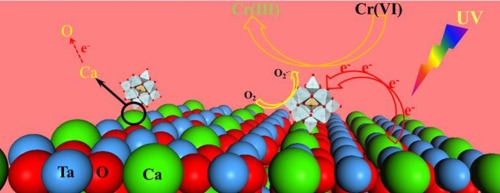Molecular Catalysis ( IF 3.9 ) Pub Date : 2018-05-31 , DOI: 10.1016/j.mcat.2018.02.026 Chunyan Wang , Yuli Ma , Junyu Lang , Zhanli Chai , Guangshe Li , Xiaojing Wang

|
A novel heterogeneous photocatalyst CaxH4-xSi4W12O40/Ca2Ta2O7 was prepared by planting silicotungstic acid on the surface of calcium tantalate. The materials are characterized by X-ray diffraction (XRD), scanning electron microspectroscopy (SEM), X-ray photoelectron spectroscopy (XPS), Fourier transformation infrared spectroscopy (FTIR), UV–vis diffuse reflectance spectroscopy (UV–vis), Energy-dispersive X-ray spectroscopy (EDS), BET surface area, and Malvern ZEN3690 Particle Analyzer (ZP). The results recovered Ca2Ta2O7 presented regular octahedron morphology with the cubic phase structure, and H4Si4W12O40 uniformly grew on the surface of Ca2Ta2O7 with the form of CaxH4-xSi4W12O40. The primary Keggin structures of H4Si4W12O40 was found to remain intact as noticed by XRD and FTIR. The modification of H4Si4W12O40 on Ca2Ta2O7 surface contributed the increase in negative zeta potential and red shifts. The as-prepared catalyst exhibited greatly enhanced UV photocatalytic efficiency in the reduction of Cr(VI) ions as high as 94.6% under the optimum conditions (Ca2Ta2O7 to H4Si4W12O40 was 1:2). Moreover, the composite presented an excellent reusability, which was mainly ascribed to the locally formation of water-insoluble CaxH4-xSi4W12O40. A probable mechanism involved in the enhanced reducible activity and well recycled performance via CaO binding linkage of H4Si4W12O40 and Ca2Ta2O7 is proposed by DFT simulation. This work will be significant in the design of heteropoly acid as stable heterogeneous photocatalyst applied to heavy metal ions reduction.
中文翻译:

通过在钽酸钙表面种植硅钨酸来还原Cr(VI)的新型多相光催化剂
通过在钽酸钙表面种植硅钨酸,制备了新型的非均相光催化剂Ca x H 4-x Si 4 W 12 O 40 / Ca 2 Ta 2 O 7。这些材料的特征在于X射线衍射(XRD),扫描电子显微镜(SEM),X射线光电子能谱(XPS),傅里叶变换红外光谱(FTIR),UV-可见漫反射光谱(UV-vis),能源色散X射线光谱(EDS),BET表面积和Malvern ZEN3690粒子分析仪(ZP)。结果回收了Ca 2 Ta 2 O 7H 4 Si 4 W 12 O 40具有立方相结构的规则八面体形态,并且在Ca 2 Ta 2 O 7表面上以Ca x H 4-x Si 4 W 12 O 40的形式均匀生长。XRD和FTIR发现,H 4 Si 4 W 12 O 40的一级Keggin结构保持完整。H 2 Si 4 W 12 O 40在Ca 2上的改性Ta 2 O 7表面有助于负ζ电势的增加和红移。在最佳条件下(Ca 2 Ta 2 O 7至H 4 Si 4 W 12 O 40为1:2),所制备的催化剂在还原Cr(VI)离子方面显示出大大提高的UV光催化效率,高达94.6%。。此外,该复合材料具有极好的可重复使用性,这主要归因于局部形成水不溶性Ca x H 4-x Si 4 W 12 O 40。通过DFT模拟,提出了通过H 4 Si 4 W 12 O 40和Ca 2 Ta 2 O 7的Ca O结合键增强还原活性和良好循环利用性能的可能机理。这项工作对于杂多酸的设计具有重要意义,因为杂多酸是一种稳定的均相光催化剂,可用于重金属离子的还原。











































 京公网安备 11010802027423号
京公网安备 11010802027423号